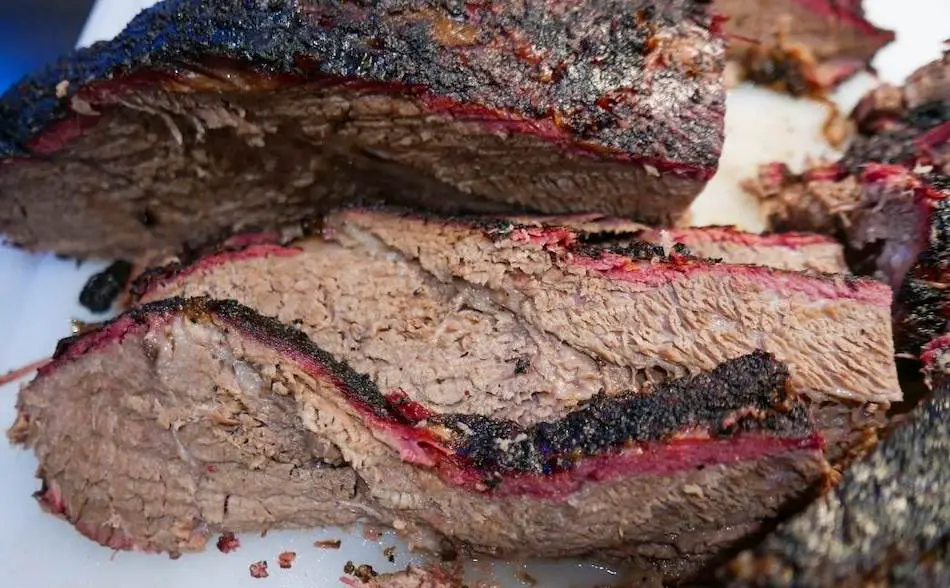
Cooking a delicious, tender brisket requires careful time management. With so many variables at play, it can be tough to know exactly how long your brisket will take to smoke. To help you plan your cook and avoid any last-minute stress, we’ve gathered all the key factors that influence the total cook time of a brisket. Read on to learn more and get the perfectly cooked brisket every time.
On average, it will take a brisket between 1.5 hours to 2 hours per pound when cooking in the low and slow range (220°F – 250°F). However, the total cook time is influenced by many variables, such as the thickness of the meat, wrapping, weather, humidity, spritzing, thermometer accuracy, meat grade and other factors. Expect a whole brisket between 11 and 18 hours if wrapped, and 15 to 20 hours for a naked unwrapped brisket.
Key Points
- Average cook time for brisket is 1.5-2 hours per pound when cooking at low and slow temperatures (220°F-250°F)
- Total cook time is influenced by various factors such as meat thickness, wrapping, weather, humidity, spritzing, thermometer accuracy, meat grade, and others
- Estimated cook time for a whole wrapped brisket is 11-18 hours, and 15-20 hours for an unwrapped brisket
- 14 factors that influence total cook time: meat thickness, temperature, indirect cooking, heat deflectors, grate level, wrapping, humidity and weather, spritzing, meat grade, thermometer accuracy, practice and experience, amount of charcoal or wood, using a water pan, and final internal temperature of the meat
- To ensure accurate cook time estimation, consider the size and shape of the brisket, maintain a stable temperature, use indirect heat, use heat deflectors if available, consider the position of the brisket in the smoker, wrap the brisket if desired, take weather and humidity into account, use a thermometer to check the meat’s temperature, and practice and gain experience.
Estimated Cooking Time For Brisket
| Brisket Size | Temperature | Cook Time | Including Resting |
| 12 lbs | 225°F | 18 hours | 19 hours |
| 18 lbs | 250°F | 18 hours | 19 hours |
| 12 lbs unwrapped | 225°F | 19 hours | 20 hours |
| 18 lbs unwrapped | 250°F | 19 hours | 20 hours |
| 16 lbs | 275°F | 10 – 12 hours | 11-13 hours |
| 16 lbs unwrapped | 275°F | 11-13 hours | 12-14 hours |
1. The Size of the Brisket Influences the Total Cook Time
The size and shape of the brisket can greatly impact the total cook time. A “packer” brisket, which includes both the point and the flat, will typically be larger and thicker than a brisket flat on its own. The point, which is the thicker end of the brisket, contains more fat and connective tissue that needs to be broken down during the cooking process, which can take longer.
On the other hand, the flat is a thinner cut of meat with less fat and connective tissue, so it will generally cook faster. As a result, a huge packer brisket may take up to 20 hours to cook, while a smaller, thinner brisket flat may only take 5-7 hours. It is important to consider the size and shape of the brisket when estimating the total cook time to ensure that it is cooked to the desired level of tenderness.
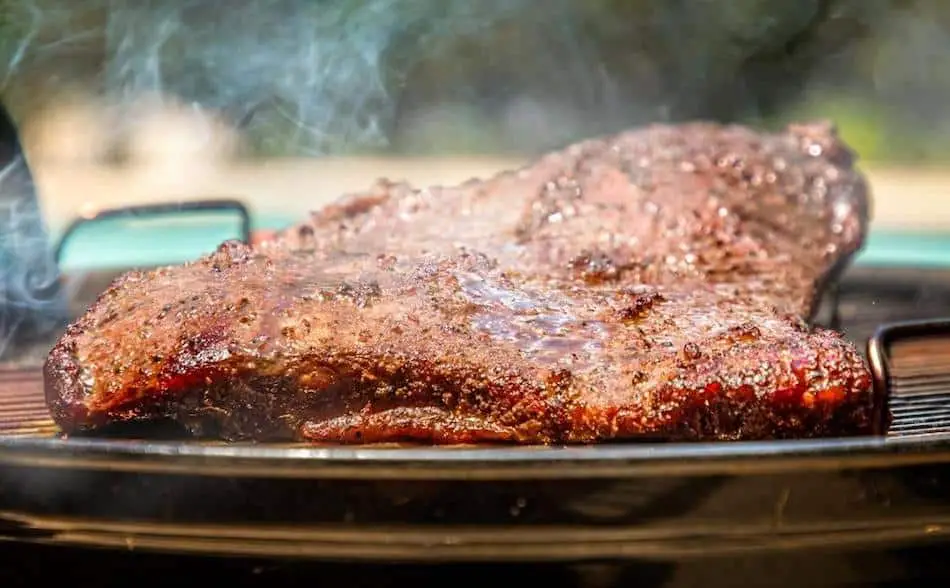
2. The Temperature of Your Smoker
The brisket cook time will largely depend on the temperature of your smoker. Obviously, if you set your smoker to a higher temperature, the brisket will be done sooner. If you’re doing a low and slow cook, then the brisket will take longer.
A standard low and slow temperature for a brisket is usually somewhere between 220°F and 250°F. If you maintain this temperature, a full brisket will take between 12 to 20 hours. However, the exact time will depend on the size of the brisket, and whether or not it was wrapped.
Having a good understanding of your smoker is critical because you need to maintain a stable temperature. You also need the right tools for the job, and meat thermometers are your best friend when smoking brisket.
3. How You Position the Brisket in the Smoker
Where your position the brisket in your smoker will also determine the total cook time. Even if your smoker is running at 220°F, if your meat is sitting directly above the flames, then it will cook faster than it would with indirect heat. We call this two-zone cooking. The hot-zone is above the fire or the heat source, and the cool-zone is further away from the heat source. The secret to low and slow cooking is keeping meat in the cool zone to cook with indirect heat.
4. Heat Deflectors
Heat deflectors are a useful tool for creating two-zone cooking on some types of smokers and grills. By placing a heat deflector between the heat source and the food, it’s possible to create a cooler area on the grill where the food is indirectly exposed to heat.
This can be helpful for smoking a brisket, as it allows you to slow down the cooking process and produce a more tender, flavorful result. Without a heat deflector, the meat is more directly exposed to heat, which can cause it to cook more quickly. It’s important to note that not all smokers and grills are designed to be used with a heat deflector, so it’s important to check your particular model before attempting to use one.
5. Temperature Differences Between Grill Grates
The position of the brisket on the smoker can have a significant impact on the cook time. When a brisket is placed on a higher rack, it is farther from the heat source, which means it will cook more slowly than a brisket placed on a lower rack. Similarly, on a vertical smoker with multiple racks, the rack closest to the heat source will tend to cook the brisket faster than the upper racks.
Using a multi-probe thermometer can help you monitor the temperature of the brisket on different racks, and rotating the meat can help ensure that it cooks evenly. However, it’s important to note that rotating the meat too frequently can disrupt the formation of a flavorful, crusty bark on the surface, so it’s a good idea to use your judgement and rotate the meat as needed to achieve the desired result.
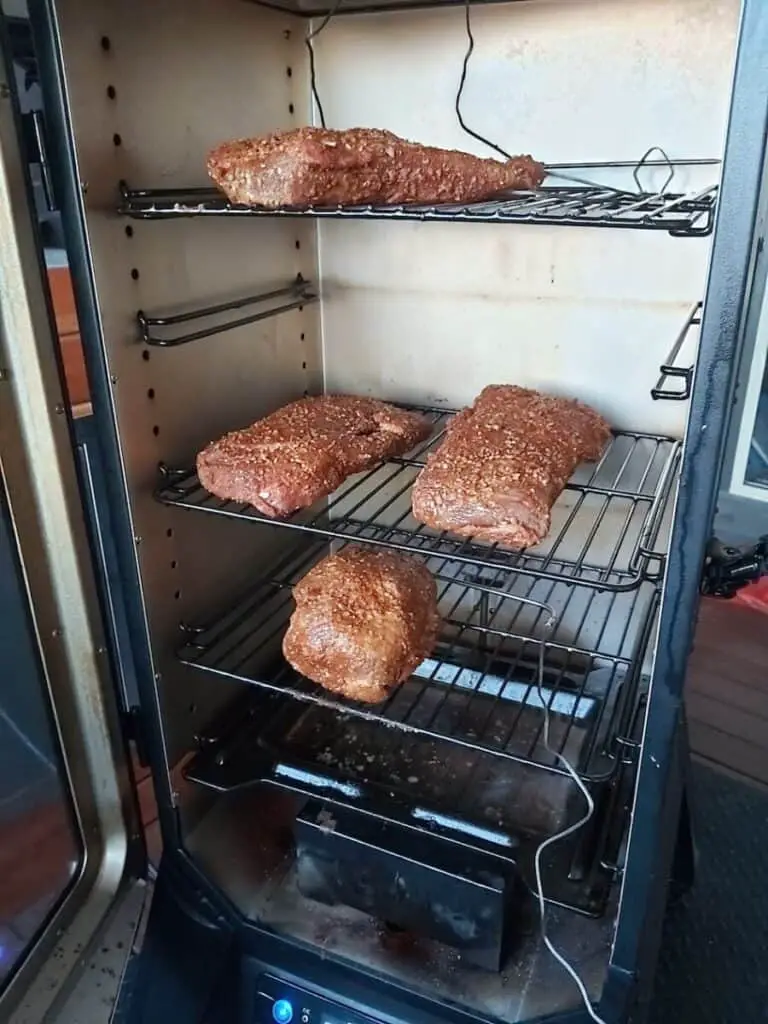
6. Wrapping Speeds Up the Cook
Wrapping a brisket during the smoking process can indeed help to reduce the overall cook time and help the meat reach the desired level of tenderness. When a brisket is wrapped, it is sealed in a foil or butcher paper, which helps to hold in the heat and steam, speeding up the cooking process.
Wrapping can also help to push the brisket through the “stall,” a period during the cooking process when the internal temperature of the meat plateaus and stops rising. This can be frustrating for pitmasters, as it can extend the cook time significantly. Wrapping can help the meat to continue cooking and break through the stall more quickly.
On the other hand, smoking a brisket unwrapped, or “naked,” will generally result in a longer cook time. While the bark, or crusty exterior, of the brisket may be more flavorful and crispy when smoked naked, the meat may be less moist and tender compared to a wrapped brisket.
However, if you’re able to achieve a good bark during the first stage of the cook and then wrap the brisket to finish, you can still get the benefits of a tender, juicy brisket while preserving some of the bark’s crunchiness. Simply remove the foil or butcher paper during the final stages of the cook and allow the bark to dry out over the flame before slicing and serving.
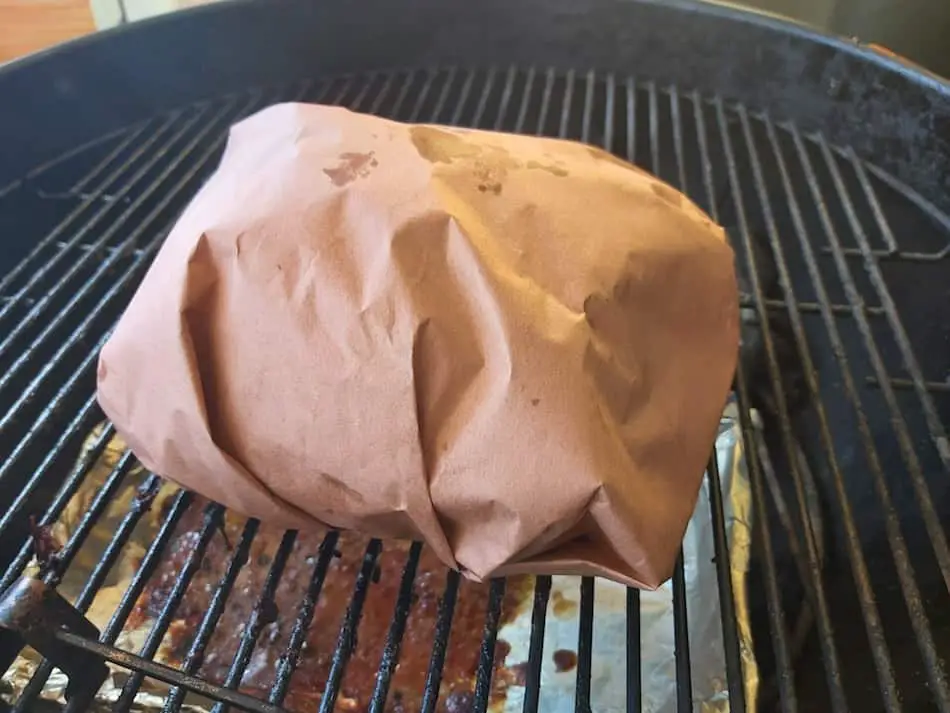
7. High Quality Meat Cooks Faster
The grade of beef can indeed affect the total cook time of a brisket. Higher grades of beef, such as USDA Prime, tend to contain more fat and marbling, which can make the meat more tender and flavorful. These higher-fat cuts of meat can also cook more quickly, due to the additional fat content.
On the other hand, lower grades of beef, such as USDA Select, tend to have less fat and marbling, which can make the meat less tender and flavorful. These leaner cuts of meat may require a longer cook time to reach the desired level of tenderness.
In general, you can expect a brisket made from a higher-grade beef, such as USDA Prime, to cook around 30 minutes faster than a brisket made from a lower-grade beef, such as USDA Select. However, it’s important to note that the total cook time will also depend on a variety of other factors, such as the size and thickness of the brisket, the cooking temperature, and the type of smoker or grill being used.
To get the best results, it’s a good idea to use a meat thermometer to monitor the internal temperature of the brisket as it cooks, and to wrap or unwrap the meat as needed to achieve the desired level of tenderness.
8. Spritzing Slows the Cook
Spritzing or mopping the brisket will also impact on the total cook time. Most people will tell you to spritz or mop a brisket every hour for the first 5 or 6 hours of the cook. Wetting the brisket will cool the meat and therefore slow down the cook.
The other problem with regular mopping or spritzing is it will destabilize the temperature of your smoker. If you’re spritzing every hour, this means you will be opening the lid regularly. Constantly opening the lid of your smoker will cause temperature fluctuations, especially if it’s a cold day. Smokers will work twice as hard on a colder day, so you want to keep all the precious heat inside the cook chamber.
It can take a long time for your smoker to come up to temperature on a chilly day, so if you open the lid every hour, all the heat in the smoker will get sucked out.
Opening the lid to mop or spritz can also spike the temperature of your smoker. Whenever you open the lid to spritz, the fire will get a huge shot of oxygen and raise the temperature. Sometimes it’s easier to just leave the brisket alone for the first 5 to 6 hours. At least the temperature of your smoker will remain stable.
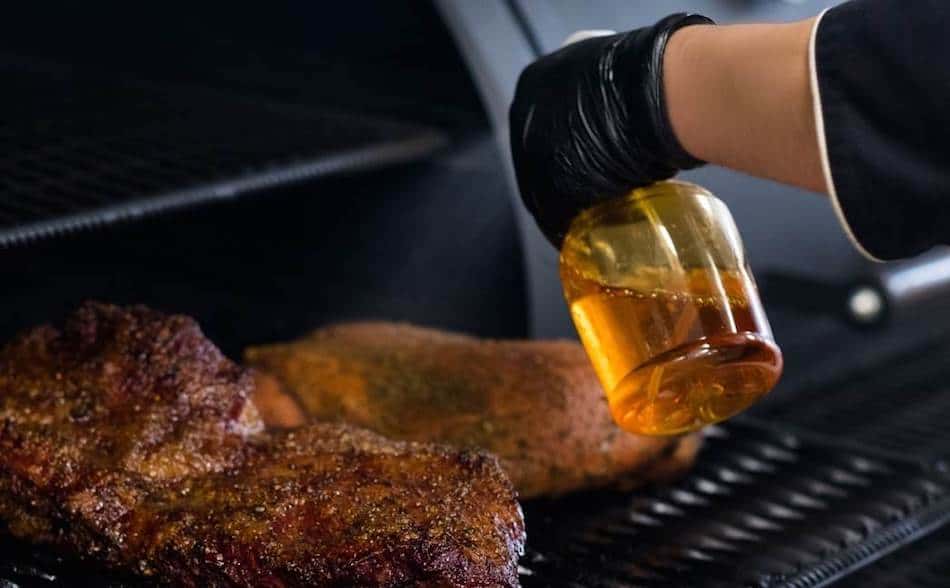
9. Weather Causes Temperature Fluctuations
Weather can have an enormous impact on the total cook time of your brisket. If it’s a wintry day, the cold air will get drawn in through your vents and slow cool down the smoker. In summer, the vents will draw hot air into the smoker, which will increase the temperature.
If your smoker is out in the open, the wind and rain can cool the exterior of your smoker, which will also have an influence on the temperature. All these factors contribute to the total cook time of your brisket.
10. Humidity Slows Down the Cook
If you are cooking your brisket in high humidity, there will be an increased level of water vapors in the smoker. This will have a cooling effect on the brisket and therefore slow down the cook. To avoid this happening, increase the temperature otherwise your brisket will stall.
11. The Stall Causes the Brisket to Plateau
The stall is another factor that occurs and can add hours onto the total cook time. The stall takes place when the brisket sweats. Moisture evaporates to the surface of the meat and cools the brisket, which slows the cook.
The stall is extremely frustrating because the brisket can’t get stuck at the same temperature for hours upon hours. A brisket will usually stall anywhere after the internal temperature hits 150°F. It can remain at the same temperature before quickly increasing up to the done temperature of 203°F.
The best way to push the brisket past the stall is by increasing the temperature of your smoker or wrapping. Once you have wrapped the brisket in either foil or butcher paper, it can take 2 hours off the total cook time. When a brisket is wrapped, all the heat gets trapped inside and the moisture steams the meat.
12. Thermometers May Be Inaccurate
Another consideration is your thermometer could give you false readings. Make sure the thermometers you are using are accurate, otherwise you are driving blind. If a thermometer is inaccurate, then what’s the point? Check out my thermometer guide to find out all there is to know about meat thermometers.

13. Altitude Makes a Difference
If you live at a higher altitude, (3,500 feet above sea level), this will make your brisket take longer to cook. Air pressure is much lower at high altitudes, which means there will be less oxygen in the fire. Cooking at high altitude will also cause moisture to evaporate faster, effect boiling temperatures and cause gases to expand.
14. Resting Time
Always allow for an extra 2 hours for the brisket to rest before slicing and serving. Cook times rarely include resting times. Rest the brisket anywhere from 1 hour up to 4 hours. Place the brisket in a dry cooler and wrap in a towel. This will hold the brisket for hours or until you are ready to serve. Resting will give the meat a chance to reabsorb some of the moisture. If you were to slice too early, all the precious meat juices would spill out onto the cutting board. If you don’t allow the brisket to rest, the meat will become dry.

Brisket Cooking Planner
| Brisket Total Cook Time | Start Time | Begin Spritzing | Wrap Brisket | Finish in Oven | Done Time (203°F) | Holding Time In Dry Cooler (1-4 hours) |
| 12 hours | 6pm | 9pm | 12am | 12am | 6am | Between 7am – 10am |
| 15 hours | 5pm | 8pm | 11pm | 11pm | 8am | Between 9am – 12pm |
| 18 hours | 2pm | 5pm | 8pm | 8pm | 8am | Between 9am- 12pm |
Brisket Rub Recipe
Standard Barbecue Rub

I found this great rub recipe through How To BBQ Right. I use this recipe and alter it slightly depending on what I'm cooking. Made by the guys at Townsend Spice & Supply: https://townsendspice.com/
Ingredients
- - ½ Cup Paprika
- - ½ Cup Salt
- - ½ Cup Sugar
- - ½ Cup Granulated Garlic
- - ¼ Cup Granulated Onion
- - ¼ Cup Chili
- - ¼ Cup Cumin
- - 2 Tablespoons Black Pepper
- - 2 Tablespoons Dry Mustard
- - 1 Tablespoon Cayenne Pepper
Instructions
- Combine all the spices together in a large mixing bowl
- Store rub in rub shakers
My Favorite Brisket Tools
Thanks for checking out this article. I hope you learned a few things. Here are some of my favorite tools I use when smoking brisket that may be useful to you. These are affiliate links, so if you decide to purchase any of these products, I’ll earn a commission. But in all honesty, these are the tools I recommend to my family and friends who are just starting out.
Meat Injector: Injecting meat is a great way to take your barbecue to the next level and help you make competition-style brisket. An injector is the only way you will be able to get flavor and moisture into the middle of the meat. The Beast Injector is a stainless steel injector that is sturdy and affordable. Check the latest price on Amazon here.
Brisket Marinade: The best injection solution on the market is the Butcher BBQ Brisket Injection. This marinade is used in competitions and is made by World Barbecue Champion pitmaster, Dave Bouska. You can find the marinade on Amazon here.
Butcher Paper: Wrapping brisket in butcher paper has become a huge trend in barbeque thanks to Aaron Franklin. Wrapping your brisket in paper will give you a nice brisket bark. However, you can’t just use any old paper, it has to be unwaxed, food grade paper. You can find it on Amazon here.
Brisket Rub: These days I make my own rub when possible, but I always have a few pre-made rubs for when I’m running low. Barbecue guru Malcom Reed produces Killer Hogs, one of the best brisket rubs I’ve found over the years. Another great rub is Slap Yo Daddy, made by brisket master and multiple World Barbecue Champion, Harry Soo.
Meat Thermometer: There are dozens of fancy thermometers on the market, but I still use my trusty TP20. For around $50, I have a high-quality meat thermometer with two probes, and can track the temperature of my smoker with one probe, and my meat with the other probe. The ThermoPro TP20 is an Amazon Best Seller because it’s the easiest thermometer to operate, is durable, highly accurate, and comes with pre-programmed meat settings.
Instant Read Thermometer: Arguably, the second most important tool you need is a fast and accurate instant-read thermometer. These tools play an important role in the latter stages of the cook when the meat needs regular checking in multiple areas. I use the ThermoPro TP19 because it can do everything a ThermaPen can do, but for a fraction of the cost. You can check out the TP19 on Amazon here.
Advanced Thermometer and Automatic Temperature Controller: Once you’re ready to take things seriously, the FireBoard 2 Drive is a six-channel Bluetooth/Wi-Fi thermometer that can monitor up to 6 pieces of meat, control and graph your cook sessions on your smartphone, and attaches to an an automatic blower that will convert your charcoal smoker to a set-and-forget. This is one of the most advanced meat thermometers on the market. You can check it out on the FireBoard website here.
